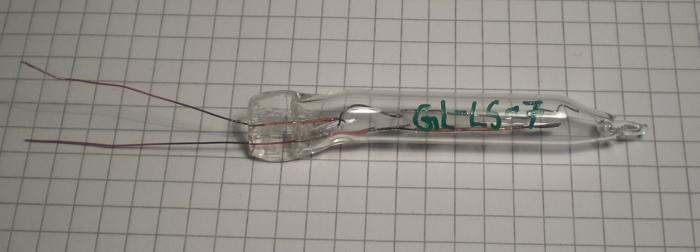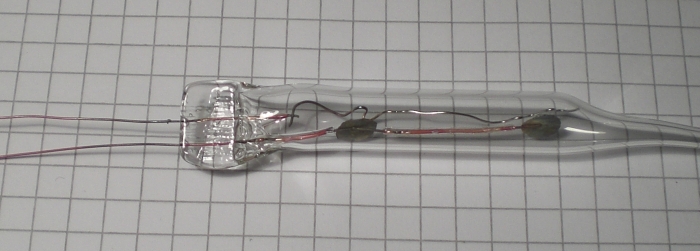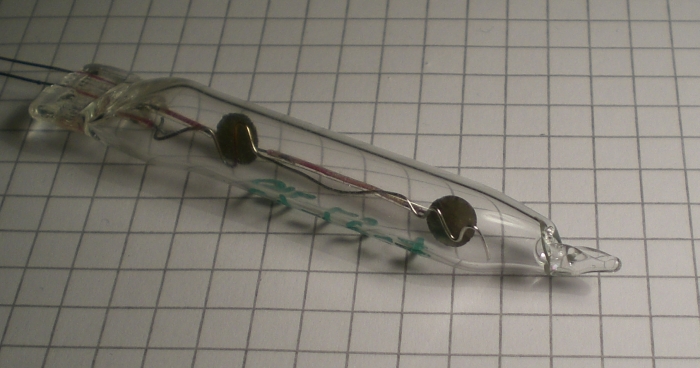www.jb-electronics.de » Elektronik » Nixie-Röhren » Selbstgebaute Nixies » GL-LS-7
GL-LS-7
Das Glow Lamp Lab Sample 7, oder kurz GL-LS-7, ist eine von mehreren Glimmlampen aus der Doppelpunkt-Experiment-Reihe. Gefertigt wurde sie aus 9mm-Kalknatron-Glasrohr, Dumet-Draht für das Quetschsiegel, Nickel-Blech für die Kathoden und Edelstahldraht für die Anode. Sie wurde ursprünglich mit Luft bei 15mbar gefüllt:

Wie zu erkennen ist, ist die GL-LS-7 leider am Vakuumsiegel geplatzt. Dennoch soll hier ihr Konstruktionsprozess vorgestellt werden.
Zunächst wurden mit einem handelsüblichen Locher zwei kreisförmige Stücke aus Nickel-Blech ausgestanzt:

Diese wurden dann mit einem verglasten Dumet-Draht verbunden:

Dann wurde diese Konstruktion, die später die leuchtende Kathode darstellen sollte, mit der Anodenkonstruktion aus Edelstahl mit Hilfe von etwas Glas verbunden:

Schließlich wurde die gesamte Konstruktion im vorverjüngten 9mm-Glasrohr untergebracht:

Das Quetschsiegel war nicht auf Anhieb ein Erfolg; es ist zu erkennen, dass es auf folgendem Bild noch nicht dicht ist (siehe den oberen Teil):

Doch mir fiel dieser Defekt auf, und nach vorsichtigem Aufwärmen gelang es mir, das Siegel erneut zu quetschen. Dieser Schritt ist bei Kalknatron-Glas alles andere als trivial, üblicherweise lässt sich diese Glassorte nur sehr schwierig wiederholt bearbeiten. Aber mit viel Vorsicht und ein bisschen Erfahrung, die ich ja schon im Bereich der Kalknatronglasbearbeitung sammeln konnte, funktionierte es hier dennoch.
Nach dem Evakuieren und anschließendem Befüllen mit Luft bei 15mbar ging jedoch beim Vakuumsiegel etwas schief: ich erhitzte die Röhre zu weit unten, wo das vorverjüngte Glas schon wieder zu weit auseinander war, sodass der Atmosphärendruck das Glas spannungsreif kollabieren ließ. Letztendlich zersprang das Vakuumsiegel während der Auskühlzeit und zerstörte so die Röhre. Hier ist der Siegelbruch sehr gut zu sehen:

Doch selbst wenn das Siegel intakt geblieben wäre: die GL-LS-7 weist eine andere konzeptionelle Schwäche auf, die die gewollte Funktionalität so oder so beeinträchtigt hätte. Denn die beiden Punkt-Kathoden, die ja beide gleichzeitig leuchten sollen, sind parallel geschaltet. Nun ist es aber in Glimmlampen so, dass bei parallelgeschalteten aber unverbundenen Kathoden das Glimmen meistens zu der Kathode springt, die einen winzigen Bruchteil näher an der Anode liegt. Unverbunden meint in diesem Kontext, dass die beiden Kathoden im Betrieb nicht mit einem gemeinsamen Glimmschlauch bedeckt sind. Das ist nicht immer der Fall, manchmal leuchtet auch die andere Kathode; aber das stabile Ansteuern beider Kathoden über einen Draht ist fast unmöglich.
Woher weiß ich das, funktioniert die GL-LS-7 ja nicht? Ganz einfach: von der GL-LS-8, die eine fast identische interne Konstruktion aufweist.